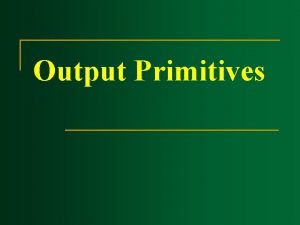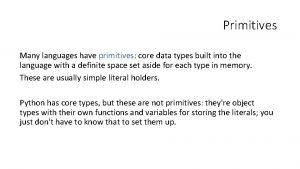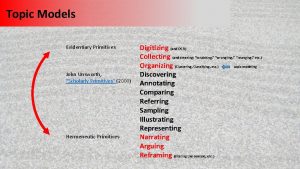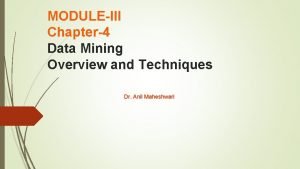Chapter4 Data Mining Primitives This work is created












- Slides: 12

Chapter-4 Data Mining Primitives This work is created by Dr. Anamika Bhargava, Ms. Pooja Kaul , Ms. Priti Bali and Ms. Rajnipriya Dhawan and licensed under a Creative Commons Attribution 4. 0 International License.

A popular misconception about data mining is to expect that data mining systems can autonomously dig out all of the valuable knowledge that is embedded in a given large database, without human intervention. A more realistic scenario is to expect that users can communicate with the data mining system using a set of data mining primitives to facilitate efficient and fruitful knowledge discovery. 2

Data mining primitives: Task-relevant database or data warehouse name database tables or data warehouse cubes conditions for data selection relevant attributes or dimensions data grouping criteria Background knowledge concept hierarchies user beliefs about relationships in the data 3

Knowledge Type to be mined characterization discrimination(favoritism ) association clustering classification/prediction Pattern interestingness measurements simplicity certainty (confidence) Novelty(innovation) utility (support) Visualization of discovered patterns drill-down and roll-up rules, tables, reports, charts, graphs, decision trees and cubes 4

What does a data mining task? Adataminingtaskcanbespecifiedintheformofadata mining query, which is input to the data mining system. 1. Task-relevant Data : The first primitive is the specification of the data on which mining is to be performed. A user is interested in only a subset of the database. This is the database portion to be investigated. It is impractical to haphazardly mine the entire database, particularly since the number of patterns generated could be exponential with respect to the database size. Many of these patterns found would be irrelevant to the interests of the user. 5

Example: -suppose that a manager of All-Electronics in charge of sales in the United States and Canada. In particular, he would like to study the buying trends of customers in Canada. Rather than mining on the entire database, he can specify that only the data relating to customer purchases in Canada need be retrieved, along with the customer profile. These are referred to as relevant attributes. 6

2. Background Knowledge Users can specify background knowledge, or knowledge about the domain to be mined. This knowledge is useful for guiding the knowledge discovery process, and for evaluating the patterns found. There are several kinds of background knowledge. Background knowledge is information about the domain to be mined that can be useful in the discovery process. Concept hierarchies allow the discovery of knowledge at multiple levels of abstraction. 7

A concept hierarchy defines a sequence of mappings from a set of low level concepts to higher level. Concept hierarchies are useful in that they allow data to be mined at multiple levels of abstraction. A concept hierarchy for the dimension location is shown in mapping low level concepts (cities) to more general concepts (countries). 8

3. The kinds of knowledge to be mined This specifies the data mining functions to be performed, such as characterization, association, classification, clustering analysis. For instance, if studying the buying habits of customers in Canada, he may choose to mine associations between customer profiles and the items that these customers like to buy. It is important to specify the kind of knowledge to be mined, as this determines the data mining function to be performed. The kinds of knowledge include concept description – (characterization and discrimination) association, classification, prediction, clustering, and evolution analysis. 9

4. Interestingness Measures These functions are used to separate uninteresting patterns from knowledge. They may be used to guide the mining process, or after discovery, to evaluate the discovered patterns. Different kinds of knowledge may have different interestingness measures. Example: - Interestingness measures for association rules include support (the percentage of task-relevant data for which the rule pattern appears), and confidence (the strength of the implication rule). 10

5. Presentation and visualization of discovered patterns: This refers to the form in which discovered patterns are to be displayed. Users can choose from different forms for knowledge presentation, such as rules, tables, charts, graphs, decision trees, and cubes. we examine each of these primitives in greater detail. The specification of these primitives are summarized. 11

Thank you 12
 Data mining primitives languages and system architecture
Data mining primitives languages and system architecture Mining complex data types
Mining complex data types Multimedia data mining
Multimedia data mining Strip mining vs open pit mining
Strip mining vs open pit mining Mineral resources and mining chapter 13
Mineral resources and mining chapter 13 Difference between strip mining and open pit mining
Difference between strip mining and open pit mining Difference between text mining and web mining
Difference between text mining and web mining Data reduction in data mining
Data reduction in data mining What is kdd process in data mining
What is kdd process in data mining What is missing data in data mining
What is missing data in data mining Data reduction in data mining
Data reduction in data mining Data reduction in data mining
Data reduction in data mining Data reduction in data mining
Data reduction in data mining























